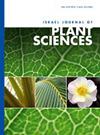Rooting of cuttings of Passiflora suberosa, a medicinal passion fruit species: characterization and modulation by external biochemical factors
IF 0.9
4区 生物学
Q4 PLANT SCIENCES
引用次数: 5
Abstract
Passiflora suberosa L. (Passifloraceae) can be found throughout the Americas, and has several medicinal properties, including antioxidant, antibacterial, anti-hemolytic, hypolipidemic, and hypoglycemic activities. Germination rates of P. suberosa are low, even with dormancy breaking treatments, posing an obstacle for its multiplication. Vegetative propagation is a valuable approach to produce clones of elite individuals with important pharmacological characteristics, affording fast genetic improvement of biomass source for both phytomedicine manufacturing and bioactive compound isolation. Understanding the rooting process of this species is an important step to exploit its full potential in a sustainable way. We investigated adventitious rooting (AR) in absence or presence of exogenous auxin in P. suberosa cuttings, using a non-aerated hydroponic system. Changes in concentration of flavonoids, phenolics, hexoses, starch, and auxin, as well as peroxidase activity, were monitored along AR. Cuttings showed spontaneous rooting, although the application of exogenous indole-3-butyric acid (IBA) yielded higher number of shorter roots. Biochemical parameters, mainly concentration of carbohydrates and total phenolics, as well as peroxidase activity, varied along the course of the experiments. Based on these results, attempts were made to up- or down-modulate rooting responses by applying putative regulators to the growth solution at different time points. It was possible to block the positive effect of auxin on root development, with only minor positive impacts on the modulated control devoid of auxin. Overall analyses suggested that the rooting system proved effective and specific peroxidase activity showed partial correlation with AR, being able to suffer modulation by culture solution factors.药用百香果木栓西番莲插穗生根特性及外部生化因子的调控
西番莲(Passiflora suberosa L.)(西番莲科)遍布美洲,具有多种药用特性,包括抗氧化、抗菌、抗溶血、降血脂和降糖活性。即使采用破休眠处理,其发芽率也很低,这对其繁殖造成了障碍。无性繁殖是产生具有重要药理特性的优良个体的一种有价值的方法,为植物药的生产和生物活性化合物的分离提供了生物质资源的快速遗传改良。了解该物种的生根过程是可持续开发其全部潜力的重要一步。本研究利用无曝气水培系统,研究了在无外源生长素或有外源生长素存在的情况下,黑松插条的不定根(AR)。黄酮、酚类物质、己糖、淀粉和生长素的浓度以及过氧化物酶活性的变化,都被监测到。尽管外源吲哚-3-丁酸(IBA)产生了更多的短根,但扦插表现出自发生根的特征。碳水化合物和总酚类物质浓度以及过氧化物酶活性等生化指标在实验过程中发生变化。基于这些结果,我们尝试通过在不同时间点的生长溶液中应用假定的调节剂来上调或下调生根响应。有可能阻断生长素对根发育的积极作用,而对缺乏生长素的调节控制只有很小的积极影响。综合分析表明,生根系统是有效的,特异过氧化物酶活性与AR呈部分相关,可受培养液因素的调节。
本文章由计算机程序翻译,如有差异,请以英文原文为准。
求助全文
约1分钟内获得全文
求助全文
来源期刊

Israel Journal of Plant Sciences
生物-植物科学
CiteScore
1.90
自引率
0.00%
发文量
17
审稿时长
>12 weeks
期刊介绍:
The Israel Journal of Plant Sciences is an international journal of extensive scope that publishes special issues dealing with all aspects of plant sciences, including but not limited to: physiology, cell biology, development, botany, genetic
 求助内容:
求助内容: 应助结果提醒方式:
应助结果提醒方式:


